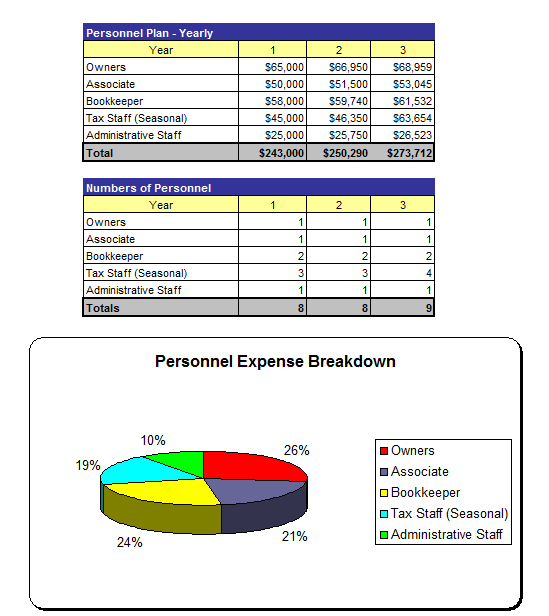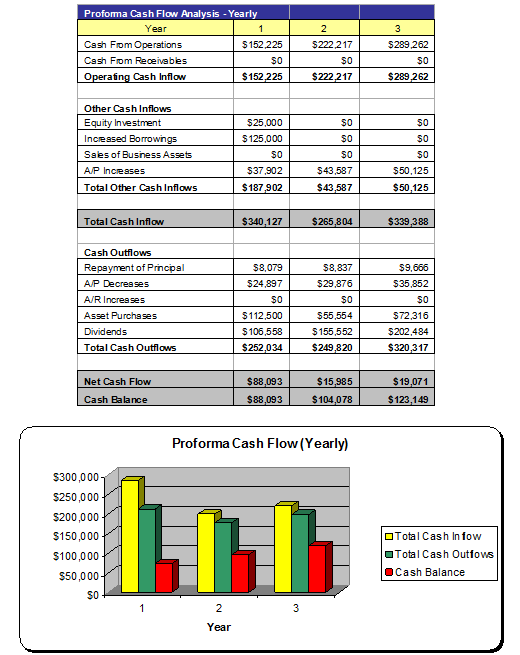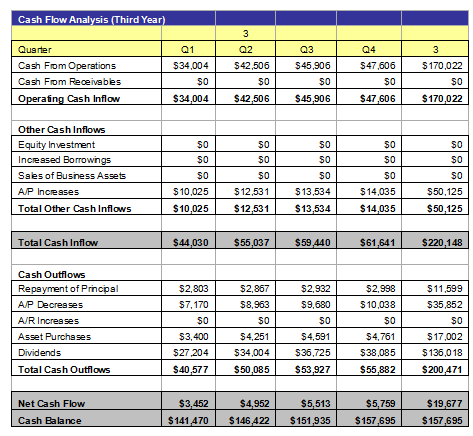Free Mall Business Plan
For Raising Capital from Investors, Banks, or Grant Companies!
Please note that the financials
in this complete free business plan are completely fictitious and may not
match the text of the business plan below. This free business plan demonstration
purposes only. If you are interested in purchasing the completed editable MS Word
and Excel documents for this business plan, please click the button below! Also,
the text of the business plan is formatted with a fully automated
table of contents.
Return to
Samples Page
It should be noted that there is no special software required to use these
templates. All business plans come in Microsoft Word and Microsoft Excel format.
Each business plan features:
- Excecutive Summary
- Company and Financing Summary
- Products and Services Overview
- Strategic Analysis with current research!
- Marketing Plan
- Personnel Plan
- 3 Year Advanced Financial Plan
- Expanded Financial Plan with Monthly Financials
- Loan Amortization and ROI Tools
- FREE PowerPoint Presentation for Banks, Investors,
or Grant Companies!
1.0 Executive Summary
The purpose of this business plan is to raise $30,000,000 for the acquisition of a 150 unit retail Mall showcasing the expected financials and operations over the next three years. Mall, Inc. (“the Company”) is a New York based corporation that will provide rental services to retail stores in its targeted market. The Company was founded by John Doe.
1.1 Products and Services
The primary revenue center for the business is acquiring and developing Mall building properties with the intent to rent the properties to retail stores. The business will generate profits from both the ongoing rental income paid to Mall, Inc. while generating capital appreciation from the long term holding of these properties. Now that that the real estate market has hit come to its bottom, Management expects that the market will have a future growth rate of 5% to 6% per year. The third section of the business plan will further document the Mall rental services offered by the business.
1.2 The Financing
Mr. Doe is seeking to raise $30,000,000 from an investor. The terms, dividend payouts, and aspects of the deal are to be determined at negotiation. This business plan assumes that an investor will receive 50% of the Company’s stock, a regular stream of dividends, and a seat on the board of directors. The financing will be used for the following: • Financing to acquire the initial Mall property. • Financing for the first six months of operation. • Capital to purchase a company vehicle.
1.3 Mission Statement
Mr. Doe’s mission is to develop Mall, Inc. into a premier regional real estate investment firm that will acquire and development Mall buildings and rent properties profitably.
1.4 Mangement Team
The Company was founded by John Doe. Mr. Doe has more than 10 years of experience in the real estate industry. Through his expertise, he will be able to bring the operations of the business to profitability within its first year of operations.
1.5 Sales Forecasts
Mr. Doe expects a strong rate of growth at the start of operations. Below are the expected financials over the next three years.

1.6 Expansion Plan
The Founder expects that the business will aggressively expand during the first three years of operation. As the real estate market returns to normal conditions, Mall, Inc. will be an excellent position to recognize profits from the sale of properties. In the future, the business may seek to acquire additional capital for the acquisition of additional Mall type properties.
2.0 Company and Financing Summary
2.1 Registered Name and Corporate Structure
Mall, Inc. The Company is registered as a corporation in the State of New York.
2.2 Required Funds
At this time, the Mall requires $30,000,000 of investor funds. Below is a breakdown of how these funds will be used:

2.3 Investor Equity
John Doe intends to sell 50% of the Mall in exchange for the capital.
2.4 Management Equity
John Doe will retain 50% of the business once the capital is raised.
2.5 Exit Strategy
If the business is very successful, Mr. Doe may seek to sell the business to a third party for a significant earnings multiple or divest the property or properties individually. Most likely, the Company will hire a qualified real estate broker to sell the properties on behalf of Mall, Inc.
3.0 Products and Services
Below is a description of the real estate services offered by the Mall.
3.1 Rental of Acquired Properties
The direct finance and purchase/development of Mall properties is the primary business of the Company. This type of real estate will provide a continuous stream of rental income that the Management will use for reinvestment and profit stability for the Company. Mr. Doe has already sourced a 15 unit retail Mall that will be initial property acquired by the business. Management is developing a complex economic pricing strategy that will determine the fair market rate of a property based on its capitalization rate in conjunction with the market values of commercial property.
4.0 Strategic and Market Analysis
4.1 Economic Outlook
Management is developing a very complex pricing method to ensure that the Company can continue to provide its units at profit despite possible drawbacks in the overall economic market. The Company’s two prong approach to real estate will allow the business to grow successfully in the rapidly changing real estate market. More importantly, this strategy will allow the Company to offset the risks from each business unit so that there is a diversified balance in the Company’s real estate portfolio. This is especially important as the business uses leverage to finance the acquisition of its properties.
4.2 Industry Analysis
Mall, Inc. plans to actively pursue a real estate acquisition and development program that will focus on the purchase of multiunit commercial buildings and related complexes with the intent of creating a recurring stream of income. Management will use reasonable leverage to purchase these properties so that a positive cash flow is generated after debt service has been paid. The recurring streams of revenue generated from the rental of Mall property will allow the Company to continually recognize revenue despite drawbacks in the real estate market. As these properties increase in value through capital appreciation, the Company will divest of these properties to reap its capital gain profits. The Company will divest its properties once Management feels that its real estate holdings have become overvalued. Mr. Doe has worked diligently to create a pricing model that will allow the business to understand when the properties have become overvalued. This model will examine the capitalization rates of the income producing properties for a determination of true asset value. There are tremendous tax benefits for the Company as it engages its real estate investments. As the business makes its real estate divestitures, The Company will recognize capital gain income rather than income on its properties. These windfall gains will be taxed at a rate that is significantly lower than the federal regular income tax levels. This assumes that the business will divest its properties after one year’s time
4.3 Customer Profile
As the Company intends to operate among several different investment and operating units, it is hard to characterize any specific type of retail tenant that will occupy the Company’s Mall property. However, Management will enact strict tenant quality and credit review procedures to ensure the Company’s revenues will not be interrupted by tenant default.
4.4 Competitive Analysis
Since real estate is effectually one of the most free market oriented businesses in the country, competition can not be accurately categorized. Mall, Inc. anticipates that there will be a sizable amount of competition from both single owner investment firms to large construction companies that are seeking to gain from the unusually high real estate prices throughout the New York metropolitan area.
5.0 Marketing Plan
Mall, Inc. intends to maintain an extensive marketing campaign that will ensure maximum visibility for the acquired units in its targeted market. Below is an overview of the marketing strategies and objectives of the Company.
5.1 Marketing Objectives
-
• Establish relationships with other real estate brokers and agents within the targeted market.
-
• Implement a local campaign with the Company’s targeted market via the use of flyers, local newspaper advertisements, and word of mouth.
-
• Develop an online presence by acquiring accounts for major online real estate portals.
5.2 Marketing Strategies
Retail property renter marketing will be the most difficult portion of the marketing strategy. This task will be accomplished through the business’s broad marketing campaign throughout its targeted market. Primarily, Mr. Doe intends to use local real estate brokerage firms to place tenants with the Company’s retail focused Mall. In addition to using a real estate broker, Mr. Doe intends to develop his own marketing strategies that will further increase the visibility of the business’s retail store units. This is especially important with the current real estate market environment. Mall, Inc. will also use an internet based strategy. This is very important as many people seeking real estate for rent use the Internet to conduct their preliminary searches. Mr. Doe will register Company and its initial Mall facility and subsequent properties with these online portals so that potential renters can easily reach the business. The Company will also develop its own online website. The Company will maintain a sizable amount of print and traditional advertising methods within local markets to promote the property that the Company is renting.
5.3 Pricing
In this section, describe the pricing of your services and products. You should provide as much information as possible about your pricing as possible in this section. However, if you have hundreds of items, condense your product list categorically. This section of the business plan should not span more than 1 page.
6.0 Organizational Plan and Personnel Summary
6.1 Corporate Organization

6.2 Organizational Budget

6.3 Management Biographies
In this section of the business plan, you should write a two to four paragraph biography
about your work experience, your education, and your skill set. For each owner or
key employee, you should provide a brief biography in this section.
7.0 Financial Plan
7.1 Underlying Assumptions
-
• Mall will have an annual revenue growth rate of 6% per year.
-
• The Owner will acquire $30,000,000 of investor funds to develop the business.
-
• The Company will not seek debt financing in the first three years of operations.
7.2 Sensitivity Analysis
The Company’s revenues can change depending on the general economic climate of the real estate industry. In times of economic recession, the Company may have issues with its top line income and rental income may decrease. However, the highly recurring nature of the Mall’s rental income streams will ensure that the business is able to maintain profitability and a positive cash flow at all times.
7.3 Source of Funds

7.4 General Assumptions

7.5 Profit and Loss Statements

7.6 Cash Flow Analysis

7.7 Balance Sheet
 .
.
7.8 General Assumptions

7.9 Business Ratios

Expanded Profit and Loss Statements




Expanded Cash Flow Analysis



